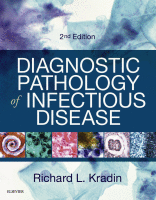Physical Address
304 North Cardinal St.
Dorchester Center, MA 02124

The histopathologic study of infections of the eye and ocular adnexa is a daunting undertaking given the variety of tissues comprising this proportionately small area of the body with extensive exposure to the external environment. Only one previous summary of…

Cutaneous infections are very common and can be caused by a wide variety of different organisms. In addition, it is not uncommon to find involvement of more than one infectious agent affecting the skin, particularly in immunocompromised individuals. Following the…

Introduction The central nervous system (CNS) is well protected and separated from the rest of the body by a thick physical barrier, the skull and the spine, and by a finer blood–brain barrier. Therefore infections of the CNS occur by…

The placenta is a fetally derived organ present in the maternal uterus; it has many different functions, including serving as a barrier to infection. Maternal infectious diseases and vaginal colonization can lead to congenital infections if the placental barrier is…

Because the female genital tract comprises both cutaneous and mucosal surfaces in contact with the external environment, exposure to a significant number of infectious agents, either commensal or pathogenic, is the norm. And because the lower genital tract is in…

Infections of the genitourinary tract can be caused by a number of viral, bacterial, fungal, and parasitic organisms ( Table 16.1 ). Although many of these organisms are also seen in other locations, some of them have a predilection for…

Pathogenic involvement of joints and other synovium-lined structures, including tendon sheaths and bursae, is a relatively uncommon but important form of infection. Its significance is related to the severe destruction of musculoskeletal structures it can cause, which often results in…

Osteomyelitis is defined literally as inflammation of bone and marrow, albeit, the common use of the term virtually always implies infection. Infection of the skeleton, the largest organ system of the body, is important because it is a major site…

The bone marrow and spleen may be affected by a wide variety of infectious agents. Pathologists must be aware of the clinical concern for infection to initiate appropriate studies to detect microorganisms and be prepared to recognize features of infection…

Lymph nodes play an important role in reaction to infectious processes. In many cases the histologic changes are nonspecific and a particular etiology cannot be assigned; in other cases the findings are characteristic of specific entities. This chapter focuses on…